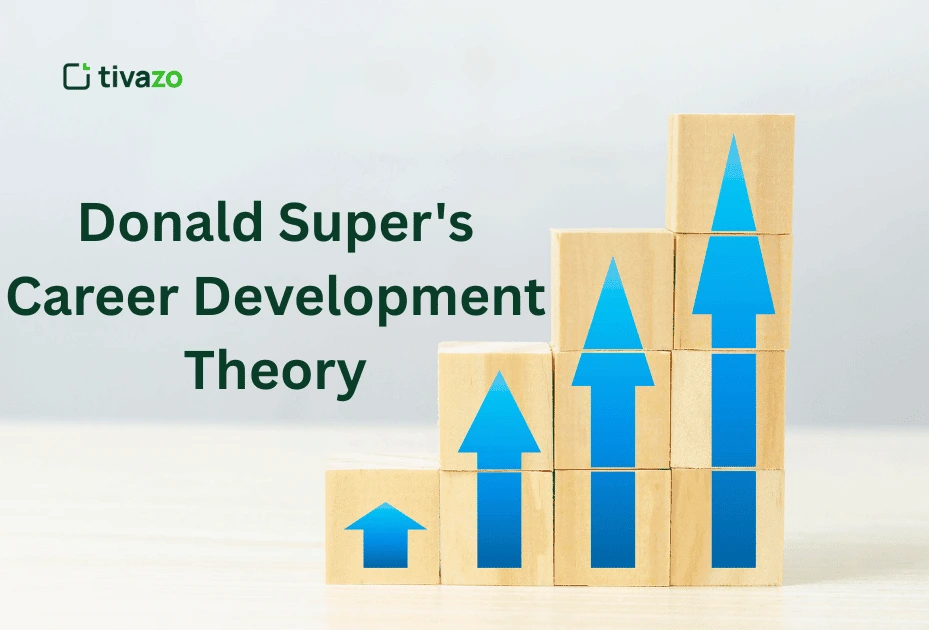Are you curious about why your experience at work is always shifting? Thinking about why the job you wanted at 25 isn’t as interesting to you when you are 45? There may be an answer in a major framework called the Donald Super Career Development Theory.
It is important in today’s fast environment to see how your career develops over the years. This theory isn’t limited to how we pick our jobs. It is concerned with how your view of yourself is developed and how it shapes your work over the years.
We should now explore this important theory to find out how you can make a plan, remain adaptable, and succeed in your job.
Key Highlights:
- Key Pillars of Donald Super Career Development Theory
- Five Stages of Donald Super Career Development Theory
- Super’s Career Development Theory Pros and Cons
- Donald Super Career Development Theory Implementation
- Super’s Theory vs. Holland’s and Krumboltz’s Career Theories
What Is Donald Super Career Development Theory?
According to the Donald Super Career Development Theory, career development should be seen as always ongoing. Proposed by Donald E. Super, this theory looks at how a person’s view of themselves changes with time and affects their career decisions.
Super thought that, unlike earlier ideas, people experience different stages and roles in their work life. For this reason, career development changes as time goes on are unique for everyone and depend greatly on self-awareness.
Key Pillars of Donald Super Career Development Theory

1. Self-Concept in Career Development
The main focus of the Donald Super Career Development Theory is self-concept. Our self-concept is created, according to Super, by our experiences, relationships, and how we view ourselves. Maturity changes our idea of ourselves, and this influences our careers as well.
Many choose jobs that reflect who they think they are. If a person sees themselves as creative, they might choose design or marketing as a career. When a job shows who they think they are, people usually feel more satisfied.
2. Life-Span, Life-Space Approach
Donald Super career development theory pointed out that people typically have different roles in their lives over time. These roles are student, worker, citizen, parent, and homemaker. By using the Life-Span, Life-Space method, he stressed the need for career development to fit within all a person’s roles.
Making sure these roles are balanced helps you feel happy about your career and life. Careers and personal life go hand in hand, and each is affected by the different responsibilities that change over time.
You May Also Like: Best 25 Career Development Goals Examples
3. Career Maturity and Adaptability
It was also in Donald Super career development theory that the ideas of career maturity and career adaptability were included. Career maturity is when a person is ready to make good choices about their career, depending on their current stage of development. Those who are growing older often have to get used to new work, technological and life changes.
Because job changes are so common now, being adaptable in your job is very helpful. It looks at how a person handles the demands and requirements of their present and future roles at work.
The Five Stages of Career Development

One of the most enduring aspects of the Donald Super Career Development Theory is its five-stage model, outlining how individuals evolve in their careers over time.
1. Growth (Birth to Age 14)
At this point, individuals start to build opinions and beliefs related to work and who they are. Playing, watching, and learning in school help them explore their environment.
Related: Strategic Expansion Services: Essential Services That Drive Business Growth
2. Exploration (Ages 15–24)
You try various jobs, begin taking part-time work, and pick your career or academic course. It covers selecting, clarifying, and putting into practice a preferred career.
3. Establishment (Ages 25–44)
People use entry-level posts, develop their abilities, and get work experience to launch their careers. It involves steps to get started and also a phase where everything is stabilized.
4. Maintenance (Ages 45–64)
People at this point strive to keep their roles, enhance their skills, and adjust to anything new happening at work or in their field.
5. Decline (Age 65 and beyond)
At this point, people prepare for retirement over time by gradually taking fewer work responsibilities. People start looking at themselves in new ways, not just defined by their jobs.
They are able to change in response to the situation. When people experience things such as layoffs, having children, or growing personally, they may return to earlier times.
Donald Super Career Development Theory Pros and Cons
Pros
- Lifespan coverage: Addresses career development from childhood to retirement.
- Holistic approach: Considers personal growth, life roles, and self-concept.
- Adaptable: Relevant across different cultures and timelines.
- Career counseling applications: Widely used in education, HR, and psychology.
Cons
- Complexity: Multiple stages and roles can be overwhelming.
- Assumes linearity: While flexible, it may still suggest a predictable path, not true for all.
- Context limitations: May not fully address economic, cultural, or gender-based disparities.
Donald Super Career Development Theory Implementation
Implementing the Donald Super Career Development Theory involves using it as a framework for career counseling, self-reflection, and organizational development. Here’s how:
For Individuals
- Use self-assessment tools to understand your self-concept.
- Map out your life roles using the Life-Career Rainbow.
- Determine your current developmental stage.
- Set realistic, stage-appropriate career goals.
For Career Counselors
- Apply stage-based questioning to understand a client’s needs.
- Help clients identify role conflicts and solutions.
- Encourage lifelong career planning and adaptability.
For Organizations
- Tailor employee development programs to fit various career stages.
- Support mid-career reskilling and late-career transitions.
- Promote a balanced life-role approach through flexible policies.
The Life-Career Rainbow
A unique component of the Donald Super Career Development Theory is the Life-Career Rainbow. This model visually represents the multiple life roles individuals perform over time and how their importance shifts.
The rainbow includes roles such as:
- Child
- Student
- Leisurite
- Citizen
- Worker
- Parent
- Homemaker
Each role is represented in a different band of the rainbow, highlighting how we juggle responsibilities and how they influence our career decisions.
This concept is critical for holistic career planning and helps professionals and counselors guide individuals toward work-life harmony.
Why Is Donald Super Career Development Theory Still Relevant Today?
With job-hopping, career changes, and remote work the “norm,” the Donald Super Career Development Theory is still very relevant today.
1. Flexibility and Lifelong View: The theory allows individuals to take a non-linear view of career development and evolution.
2. Self-discovery: The theory encourages people to focus on self-concept and growth at all stages of development.
3. Multiple Roles: The theory recognizes that we are multi-faceted, and we are more than our jobs.
4. Practicality: The theory is applicable to career practitioners, HR professionals, and people going through career transitions.
How to Apply Donald Super Career Development Theory in Your Career Planning
- Reflect on Your Self-Concept: Who are you? What values, interests, and skills define you?
- Identify Your Current Stage: Are you exploring, establishing, or maintaining?
- Map Your Life Roles: Use the Life-Career Rainbow to identify how different life roles affect your career decisions.
- Embrace Career Adaptability: Be ready to update your skills and rethink your goals.
- Seek Guidance: Work with a career counselor who uses Super’s framework for tailored advice.
Super’s Theory vs. Holland’s and Krumboltz’s Career Theories: A Simple Comparison
Choosing the right career path can be confusing, especially with so many theories out there. While Donald Super Career Development Theory emphasizes self-concept and life stages, other popular models focus on personality types or learning from experiences. Let’s break down the major differences between Super’s Theory, Holland’s Theory, and Krumboltz’s Theory to help you understand which best fits your needs.
Quick Comparison Table
| Feature/Aspect | Donald Super’s Theory | Holland’s Theory (RIASEC) | Krumboltz’s Social Learning Theory |
| Main Focus | Self-concept over time & life roles | Personality types and job environment fit | Influence of learning, experiences, and environment |
| Career Approach | Lifelong development model | Trait-factor matching | A career is shaped by learning and chance events |
| Key Elements | 5 stages of career, Life-Career Rainbow | 6 personality types (RIASEC) | Learning experiences, modeling, reinforcement |
| Self-Concept Role | The central element that evolves with age | Less emphasized | Formed through learning and experience |
| Life Roles Considered | Strong focus (student, worker, parent, etc.) | Not considered | Not primary focus |
| Career Change Friendly? | Yes – includes adaptability and role shifts | Not as adaptable | Very adaptable due to emphasis on learning |
| Practical Use | Career planning across the lifespan | Career tests and interest inventories | Coaching in dynamic or unpredictable paths |
| Best For | People reflecting on a career at any life stage | Young people exploring interests | Those dealing with unexpected career changes |
Key Takeaways
- Donald Super’s theory is ideal if you’re looking for a lifelong roadmap that evolves as you grow. It considers your whole life, not just your job.
- Holland’s theory is useful when you want to match your personality type to a career using tools like interest inventories (RIASEC).
- Krumboltz’s theory is perfect for those navigating unpredictable changes and who believe in learning from life experiences.
When to Use Each Theory in Real Life
Use Super’s Theory if you’re planning your long-term career, balancing roles (like parent or student), or considering a late-stage career change.
Use Holland’s Theory if you’re a student or job-seeker unsure about which careers align with your natural interests or personality.
Use Krumboltz’s Theory if you’ve been affected by chance events (like layoffs or relocations) and need a growth-oriented mindset.
Donald Super’s Career Theory in the Age of AI and Job Disruption

As AI and automation quickly change the way we work, Donald Super’s Career Development Theory is more important than ever. With old jobs disappearing and new ones appearing, people of all ages need to adjust, not just by gaining new skills but by rethinking what their career means to them.
Why Super’s Theory Still Matters in the Digital Age
Though developed years ago, Super’s focus on self-understanding, lifelong learning, and being flexible in your career still fits well with today’s fast-changing world. As AI changes workplaces, many are asking themselves:
- Who am I professionally?
- What value do I bring beyond technical skills?
- How can I evolve with my career, not away from it?
Super’s theory shows that careers aren’t fixed. They grow and change with who we are and with outside factors like technology and global shifts. In today’s digital world, this way of thinking about careers is not just useful—it’s necessary.
AI, Automation, and the Demand for Career Adaptability
With machines now handling repetitive tasks, many workers are forced to pivot their careers. From factory workers learning digital tools to marketing professionals upskilling in data analytics, career transitions are the new normal.
Super’s theory encourages this kind of adaptive mindset through concepts like:
- Career maturity – Assessing your readiness to make informed career decisions
- Career adaptability – Staying open to change, reskilling, and realigning your goals
- Exploration stage revisits – Going back to earlier phases of the career cycle when life demands a shift
These ideas align perfectly with the modern workforce, where it’s common to change jobs—or even entire industries—multiple times throughout a lifetime.
Reskilling and the Power of Self-Concept
As AI reshapes job descriptions, workers must reskill and upskill to stay relevant. But what often goes unspoken is the internal journey required to embrace a new professional identity.
Super’s emphasis on self-concept development is especially relevant here. You’re not just learning new tools—you’re redefining how you see yourself. This makes the transition less about survival and more about strategic career evolution.
Example:
A former HR specialist who retrained in data analysis isn’t just learning spreadsheets. They’re merging their people skills with analytics to become a data-driven HR strategist—a new identity aligned with both self-concept and job market needs.
Life Roles in a Post-Pandemic, Remote Work Era
The Life-Span, Life-Space approach of Donald Super career development theory also adapts well to the post-pandemic world, where remote work, freelancing, and hybrid jobs have changed the traditional employer-employee relationship.
Many now juggle life roles more actively:
- A parent working remotely while caring for children
- A student freelancing to fund education
- A retiree consulting part-time
Super’s Life-Career Rainbow helps individuals visualize and manage these shifting roles, making career planning more personalized and sustainable in the gig economy and beyond.
Future of Work = Continuous Career Development
The future of work is uncertain—but that’s exactly where Super’s theory shines. It provides a map, not a destination. A way to evolve with time, technology, and the changing definition of “career success.”
AI won’t replace careers—it will redefine them. Donald Super’s Career Development Theory reminds us that success lies not in resisting change, but in aligning our evolving self-concept with the opportunities of tomorrow.
You May Also Like: Top 5 SMART Goals For Career Development Examples
Re-exploration in the Age of Career Pivots
Many articles about Donald Super’s Career Development Theory don’t really dig into the idea of re-exploring your career. Today, it’s common for adults to revisit the exploration phase even after working for many years.
Whether it’s because of burnout, automation, or new chances, more people are changing careers at 35, 45, or even 60. Super’s model is flexible enough to support these changes, showing that exploration can happen more than once.
This re-exploration isn’t a step backward; it’s a sign of being adaptable and committed to learning throughout life.
Conclusion
The Donald Super Career Development Theory is more than an academic framework. It is a practical, empowering tool for navigating the complexities of career and life.
By understanding your self-concept, life roles, and developmental stage, you can make more informed, fulfilling career decisions. Whether you’re a student, mid-career professional, or approaching retirement, this theory offers guidance tailored to every life chapter.
So, take time to reflect, adapt, and plan—because your career is not a destination, but a journey shaped by who you are becoming.
Use the wisdom of Donald Super to turn that journey into a meaningful, balanced, and satisfying path.
What are the five stages of super's developmental theory?
The five stages are Growth (0–14), Exploration (15–24), Establishment (25–44), Maintenance (45–64), and Decline (65+), each reflecting changes in career goals and roles.
What is the Super's career development Inventory?
It’s a tool used to measure career maturity and readiness in adolescents and adults, helping assess their decision-making ability and alignment with career stages.
What are the strengths of supers theory?
Super’s theory is lifelong, flexible, and holistic. It considers self-concept, personal growth, and evolving roles, making it relevant across ages and career paths.




